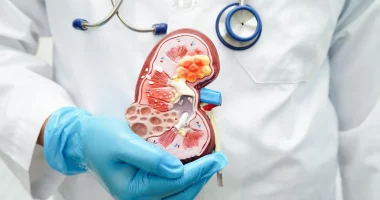Benign prostatic hyperplasia (BPH) is a state where the prostate gland becomes larger than normal. This enlargement can make it hard for urine to flow smoothly through the urethra, the tube that carries urine away from the body. The exact cause of BPH is not known.
BPH typically starts to show up in men after they turn 40. If you have BPH, you might find yourself needing to pee more often, especially during the night. You might also feel an urgent need to urinate or have trouble urinating.
It’s important to know that BPH is different from prostate cancer, even though they can have similar symptoms. Having BPH does not increase your chance of getting prostate cancer.
What is BPH?
A small gland in men that is part of the reproductive system is called the prostate. It is located just below the bladder and wraps around the urethra, which is a thin tube that transports urine and semen excreted from the body.
The prostate and the two other glands known as the seminal vesicles, produce fluid that mixes with sperm to form semen.
Normally, urine flows from the bladder through the part of the urethra surrounded by the prostate and then excreted from the body.
When someone has benign prostatic hyperplasia (BPH), the prostate gland gets larger and can stress on the urethra. This pressure can block the flow of urine and cause problems with urination.
BPH happens because the cells in the prostate increase, making the gland bigger. This condition is common as men get older.
Research shows that the average prostate gland weighs:
- 25–30 grams for men aged 40 to 49 years
- 30–40 grams for men aged 50 to 59 years
- 35–45 grams for men aged 60 years and older
BPH is not cancerous (benign), but it can cause bladder infections and other issues.
Some men with BPH might not have any symptoms and won’t require treatment. However, if the symptoms are troublesome or if there is a chance of complications, a healthcare provider might suggest treatment.
Causes
Healthcare providers are not completely sure why benign prostatic hyperplasia (BPH) happens. However, experts think that aging and hormonal changes may be involved.
Testosterone and Estrogen Balance
Men produce testosterone all over their lives and also have some estrogen but in smaller amounts. As men age, their testosterone levels decrease while their estrogen levels stay about the same. This shift in balance might cause the prostate to grow larger because estrogen may encourage prostate growth.
Dihydrotestosterone (DHT)
DHT is another male hormone that helps the prostate grow and develop. Researchers have noticed that when testosterone levels drop, DHT levels can stay high. Not all males develop DHT and those who don’t seem less likely to grow BPH. This suggests that high DHT levels might be linked to BPH.
Risk Factors
Several factors can increase the likelihood of growing benign prostatic hyperplasia (BPH).
- Age: As stated by the Prostate Cancer Foundation, around 20% of men will get BPH by their 50s. This percentage increases significantly to 70% by the period they reach the 70s.
- Family History: If a person has a close relative with BPH, they may be at a higher chance of developing the condition.
- Medical Conditions: People with certain health issues, such as obesity, type 2 diabetes, cardiovascular problems, and erectile malfunction, are more likely to develop BPH.
- Lack of Exercise: Individuals who do not engage in regular physical activity may have a higher chance of developing BPH.
While it is not likely to control all these risk factors, adopting a healthy lifestyle from a young age can be beneficial. This includes eating a nutritious diet and maintaining regular exercise, which may help reduce the risk of developing BPH.
Symptoms
Early signs of benign prostatic hyperplasia (BPH) often include needing to urinate more frequently. As the prostate enlarges, it puts more stress on the bladder, making it harder to hold in urine. These outcomes in more regular trips to the washroom, including nights.
Other common symptoms of BPH include:
- A sudden, urgent need to urinate and difficulty waiting
- Face troubles with urination
- An interrupted or weak urine stream
- Drivelling after finishing urination
- An inability to completely empty the bladder
- Feeling of pain during urination or after ejaculation
- Changes in the color and smell of urine
Approximately 10-20% of individuals with BPH also experience pelvic pain.
It’s essential to observe that not everyone with urinary issues has BPH, and also not everyone with BPH experiences these symptoms. But, someone with urinary problems should consult a doctor. Early diagnosis can prevent problems and rule out more serious conditions like cancer.
In some cases, a person without noticeable symptoms may be diagnosed with BPH during a routine prostate cancer screening test.
Complications
Without medication, benign prostatic hyperplasia (BPH) can cause several complications, such as urinary incontinence, and lack of ability to urinate or fully empty the bladder.
When urine remains in the bladder, it can cause:
- Bladder stones
- Urinary tract infections
- Kidney damage
Urinary incontinence can also negatively impact a person’s confidence and overall quality of life.
While most men with BPH do not experience complications, it is crucial for those with serious or worsening urinary problems, hurt, or blood in the urine to seek medical attention. Early intervention can prevent serious issues and improve quality of life.
When to consult a Healthcare provider
Anyone who notices changes in their urination patterns should consult a doctor. Immediate medical attention is necessary if they experience any of the following symptoms:
- Pain or a burning sensation during urination
- Blood during urination
- Lack of ability to urinate
These symptoms can indicate serious issues that require prompt evaluation and treatment.
Diagnosis
When diagnosing benign prostatic hyperplasia (BPH), the doctor considers the individual’s signs and medical history. They may also conduct tests to eliminate other conditions that have similar symptoms, like prostate cancer, prostate inflammation, or kidney stones.
Tests for BPH typically include:
- Digital Rectal Exam: The specialist inserts a gloved finger into the rectum to assess the size, shape, and thickness of the prostate gland.
- Cystoscopy: A thin tube with a light and camera on the end is inserted into the bladder and urethra to visually examine their interiors.
- Urine Tests: The test Urinalysis can help eliminate infections. Other tests evaluate the speed of urine flow, the amount of urine left in the bladder after urination, and the pressure within the bladder.
- Blood Test: PSA (Prostate-Specific Antigen) levels are measured through a blood test. Higher PSA levels may indicate prostate enlargement
- Ultrasound: This imaging scan can reveal any changes in the appearance of the prostate gland.
Additional tests may be necessary to eliminate other potential conditions.
Treatment
The treatment for benign prostatic hyperplasia (BPH) typically depends on the seriousness of symptoms, and in some cases, no medication may be necessary.
For individuals with mild or without symptoms, healthcare providers may opt for monitoring the prostate through annual exams and symptom reviews.
However, if treatment is required, there are several options available:
Medication
Medications for BPH include alpha-blockers, which relax urethra muscle tissue and bladder neck to improve urine flow, and 5-alpha reductase inhibitors, which can shrink the prostate and reduce urinary symptoms. Sometimes, a combination of drugs may be suggested.
Minimally Invasive Surgery
If medication proves ineffective, minimally invasive procedures may be recommended. These include:
- Prostatic urethral lift: Implants are inserted to lift the prostate and alleviate urethral blockage.
- Convective water vapor ablation: Steam is used to eliminate excess prostate tissue.
- Transurethral microwave therapy (TUMT): Microwaves are delivered through a catheter to destroy unwanted tissue.
- Catheterization: A tube is inserted into the bladder to facilitate urine drainage.
These treatments often improve urine flow, although further treatment may be necessary later on. Surgery may also be an option for individuals with severe symptoms, involving the removal of obstructive tissue through various procedures.
Emerging Treatment
Prostate artery embolism, a novel treatment, includes injecting substances into blood vessels leading to the prostate. However, its safety and effectiveness are still under investigation.
Some individuals may consider participating in clinical trials to access treatments that are not yet widely available. These trials offer opportunities for exploring innovative approaches to managing BPH.
Outlook
Benign prostatic hyperplasia (BPH) is not cancerous, and effective treatment options are available to manage symptoms and stop complications. It’s important to note that many individuals with BPH may not require any treatment at all.
For those experiencing symptoms or complications due to BPH, multiple interventions may be necessary to alleviate blockages. Additionally, medications can play a crucial role in preventing the recurrence of BPH symptoms.
Following the healthcare provider’s instructions is essential for individuals with symptoms or a BPH diagnosis. Adhering to medical advice and treatment plans can help effectively manage the condition and improve overall quality of life.
Summary
Benign prostatic hyperplasia (BPH) is a non-cancerous condition that affects the prostate gland, leading to urinary symptoms. Treatment options vary based on symptom severity, with monitoring, medication, and minimally invasive procedures being common approaches. While some individuals may not require treatment, others may need interventions to alleviate blockages and prevent complications.
Medications can effectively manage symptoms and reduce the likelihood of BPH recurrence. Following medical advice is crucial for effectively managing BPH and improving quality of life. Overall, while BPH is not life-threatening, seeking timely medical attention and adhering to treatment plans can significantly impact outcomes.









